Written by Shawn McCourt, Ph.D.Plant Records Keeper
Just a stone’s throw from some of the most popular beach destinations in the country, and mostly overlooked by the more than 2.5 million tourists who visit southwest Florida each year, a tall, slender, succulent plant grows in the partially shaded areas found just behind the dunes and mangroves along our coast. It’s a nationally endangered cactus called aboriginal prickly apple or Harrisia aboriginum, and it is so rare that Marie Selby Botanical Gardens’ researchers are working closely with the US Fish & Wildlife Service (USFWS) and conservation partners to help save it from imminent extinction. This species is endemic to just four counties in southwest Florida, including Sarasota, and nowhere else on earth. The aboriginal prickly apple continues to decline across its range because of human development, erosion, and invasive species dominance in its preferred coastal habitats.
In addition, there are no longer any known natural populations of Harrisia aboriginum in coastal Manatee County, so we are working with Manatee County Parks & Natural Resources and the USFWS Coastal Program to bring it back home, beginning with a trial introduction at Emerson Point Preserve in Manatee county that occurred during the summer of 2020. Seeds have also been collected from both wild and cultivated populations of Harrisia aboriginum and are being raised at Selby Gardens for reintroduction to other conservation locations in SW Florida. Our plants are in different stages of growth from 6 years to under a year old, and if you never though a plant could be cute, take a look at these pictures of our baby cacti (Fig. 1)!
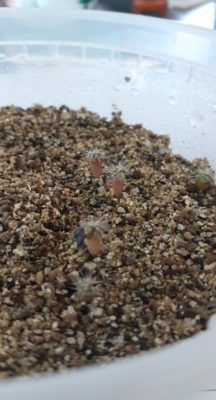
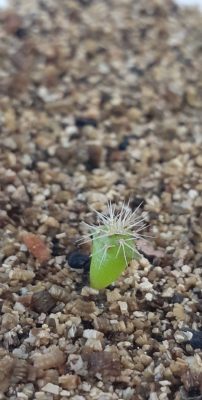
Figure 1. Young Harrisia aboriginum plants being grown out by Selby researchers and horticulturists for re-introduction into the wild. These plants were just over 3 months old at the time the photos were taken. Currently, more than 500 plants between 0 and 6 years old are being grown at Selby, possibly as many as currently exist in the wild! (photographs by Shawn McCourt)
Harrisia aboriginum is one of 20 species of Harrisia found throughout Florida and the West Indies (9 species), Cuba (5 species) and South America (6 species) (Britton & Rose 1920). Like most of the genus, Harrisia aboriginum bears large white flowers at night which are most likely pollinated by night-flying sphinx moths. In all species, the flowers are followed by yellow or red fruits that somewhat resemble commercial dragon fruit (Selenicereus undatus). The first botanical documentation of Harrisia aboriginum was in 1919 from the western shore of Terra Ceia Island in Manatee County, when John Kunkel Small, in his botanical expeditions to Florida for the New York Botanical Gardens between 1901 and 1938, discovered several colonies of a large, multi-stemmed cactus species new to science (Fig. 2). It was named Harrisia aboriginum or “aboriginal prickly-apple” because the plant bears a yellow apple-like fruit (Fig. 3) and it was observed to have a strong association with the aboriginal shell mounds of the Calusa and Manasota cultures along the Gulf Coast (Small 1921). The type specimen collected by Small and his men at Terra Ceia (Fig. 4) can be viewed online at the C.V. Starr Virtual Herbarium.
Since Small’s time, 12 populations of Harrisia aboriginum have been recorded to exist between Terra Ceia in Manatee County and Sanibel Island in Lee County. Partial surveys of all populations were carried out first in 1981(Morris & Miller), then again in 1992 (Fisher, unpublished thesis), 2004 (Bradley, et al.) and 2006 (Woodmansee et al. 2007). From all of these surveys, it was realized that the range and size of the populations were shrinking, and the species was headed towards extinction. Following a public review, USFWS then listed the species on the Federal Register of Endangered Species in 2013 and critical habitat was designated in 2015 (Dept. of the Interior 2013, 2016). Until Selby researchers took up the task, little work had been done to assess the species’ status since 2006 and in the wake of several major storms, including Hurricane Irma in 2017. Since early 2019, Selby’s botany staff members have been visiting all known populations to gather data on the numbers of plants found, the type and quality of the habitats in which they are found, and any potential threats to their continued existence. In addition, spines are being collected from up to 30 plants in each population to analyze their genetic information to determine any differences that may occur within or between populations in order to help determine which are most genetically suitable to use in specific reintroduction projects. Together, these data will help us protect this charismatic species in our own backyard from extinction.
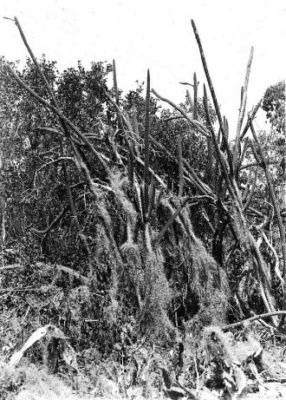
Figure 2. Type population of Harrisia aboriginum observed in bud by John Kunkel Small at “the western shore of Terra Ceia Island” (Manatee Co.) in 1919. Note the plants in Fig. 3 are heavily draped in Spanish moss (Tillandsia usneoides) a phenomenon not observed in present-day wild populations (photo by JK Small, 1919 and accessible at www.floridamemory.com).
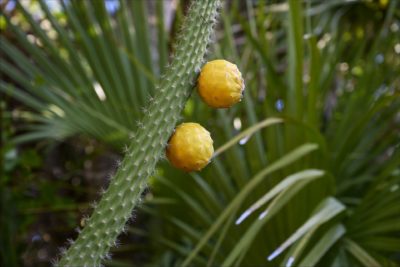
Figure 3. Yellow “apple-like” fruit of the aboriginal prickly apple on the plant and split in half exposing the hard black seeds (photo by Wade Collier)
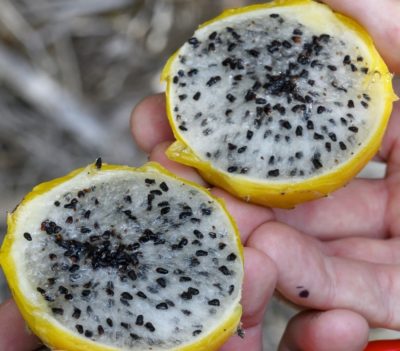
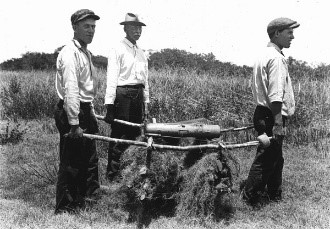
Figure 4. Small’s men collecting plants from the type population of Harrisia aboriginum at “the western shore of Terra Ceia Island” (Manatee Co.) in 1919 (photo by JK Small, 1919 and accessible at www.floridamemory.com).
Sources:
Bradley, K.A., S.W. Woodmansee, and G.D. Gann (2004). Status survey of aboriginal pricklyapples, Harrisia aboriginum Small ex Britton & Rose, in southwestern Florida. Institute for Regional Conservation, Miami, Florida.
Britton, Nathaniel L. (1908). Studies of West Indian plants – II. Bulletin of the Torrey Botanical Club 35: 561–569.
Britton, Nathaniel L. & Joseph N. Rose (1920). The Cactaceae. Vols. 1–4. Washington, D.C.: The Carnegie Institution.
Department of the Interior, U.S. Fish & Wildlife Service (2016). Endangered and Threatened Wildlife and Plants; Designation of Critical Habitat for Consolea corallicola (Florida Semaphore Cactus) and Harrisia aboriginum (Aboriginal Prickly-Apple); Final Rule 50 CFR 17. Federal Register of Endangered Species. 81 (14): 3866-3925.
Department of the Interior, U.S. Fish & Wildlife Service (2013). Endangered and Threatened Wildlife and Plants; Determination of Endangered Status for Chromolaena frustrata (Cape Sable Thoroughwort), Consolea corallicola (Florida Semaphore Cactus) and Harrisia aboriginum (Aboriginal Prickly-Apple); Final Rule. Federal Register of Endangered Species. 81 (14): 3866-3925.
Fisher, Jessica F. (1997). BEAUTY IN PERIL: CEREUS GRACILIS VAR. ABORIGINUM- THE ENDANGERED YELLOW-APPLE CACTUS. Unpublished B.A. thesis, New College of Florida.
Franck, Alan R. (2012). Synopsis of Harrisia including a newly described species, several typifications, new synonyms, and a key to species. Haseltonia 18: 95–104.
Franck, Alan R. (2013). Phylogeny, Biogeography, and Infrageneric Classification of Harrisia (Cactaceae). Systematic Botany 38 (1): 2010-223.
Franck, Alan R. (2016). Monograph of Harrisia (Cactaceae). Phytoneuron 2016 (85): 1–159.
Morris, J., and J. Miller (1981). A study of Cereus gracilis var. aboriginum in southwestern Florida. In files of the U.S. Fish and Wildlife Service, South Florida Ecological Services Office, Vero Beach, FL.
Morris, J., and J. Miller (1981). A study of Cereus gracilis var. aboriginum in southwestern Florida. In files of the U.S. Fish and Wildlife Service, South Florida Ecological Services Office, Vero Beach, FL.
Small, John K. (1921). Old Trails and New Discoveries: A Record of Exploration in Florida in the Spring of 1919. Journal of the New York Botanical Garden, 22 (254): 28-37.
Woodmansee, S.W., M.J. Barry, K.A. Bradley, S.E. Green, and J.M. Mahoney (2007). Post-hurricane field assessments of six federally endangered and candidate plant species. Institute for Regional Conservation, Miami, Florida.
